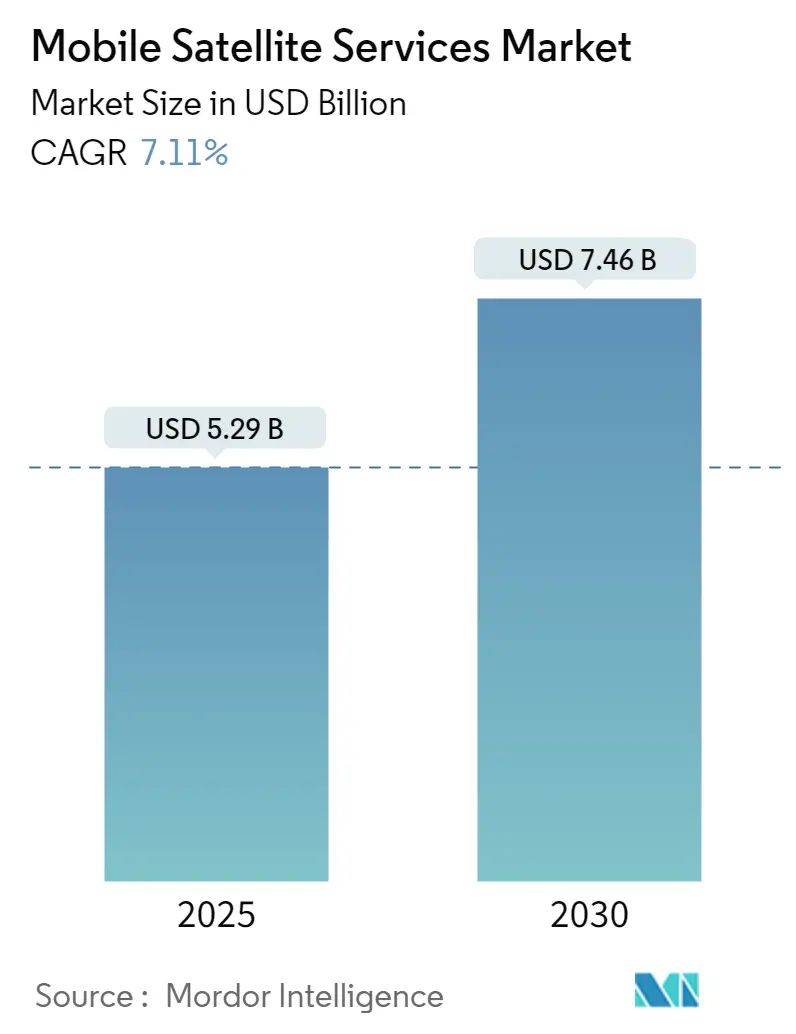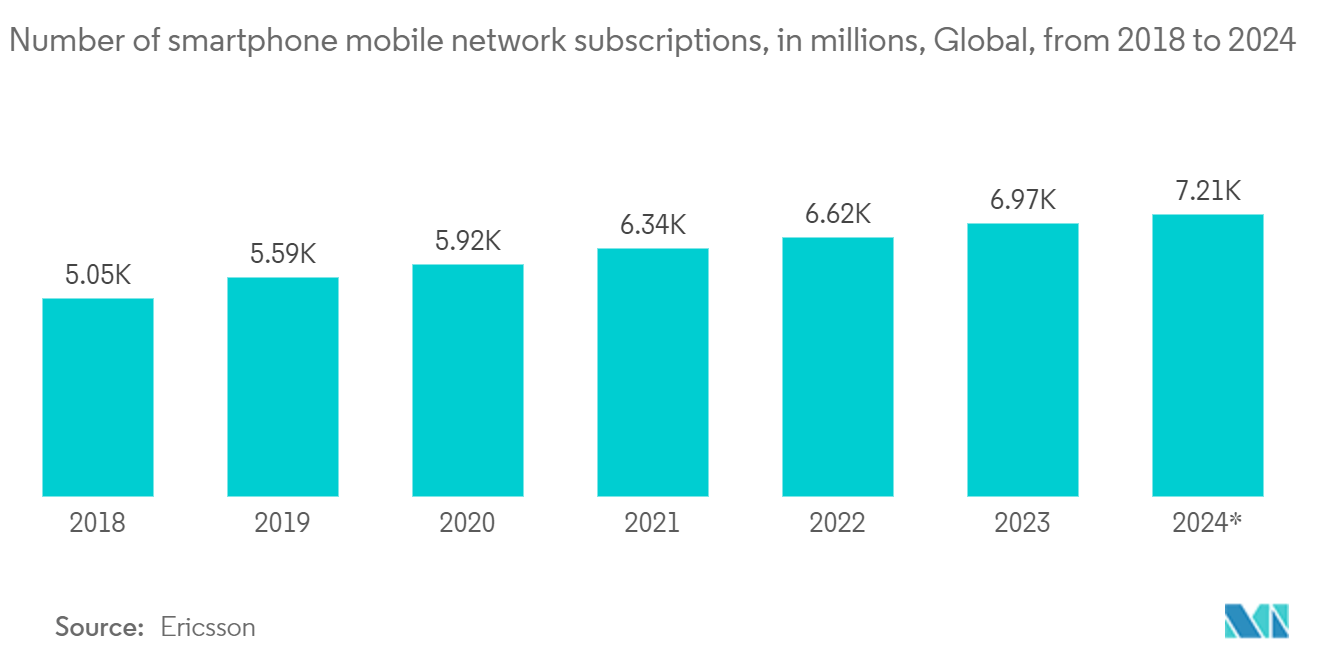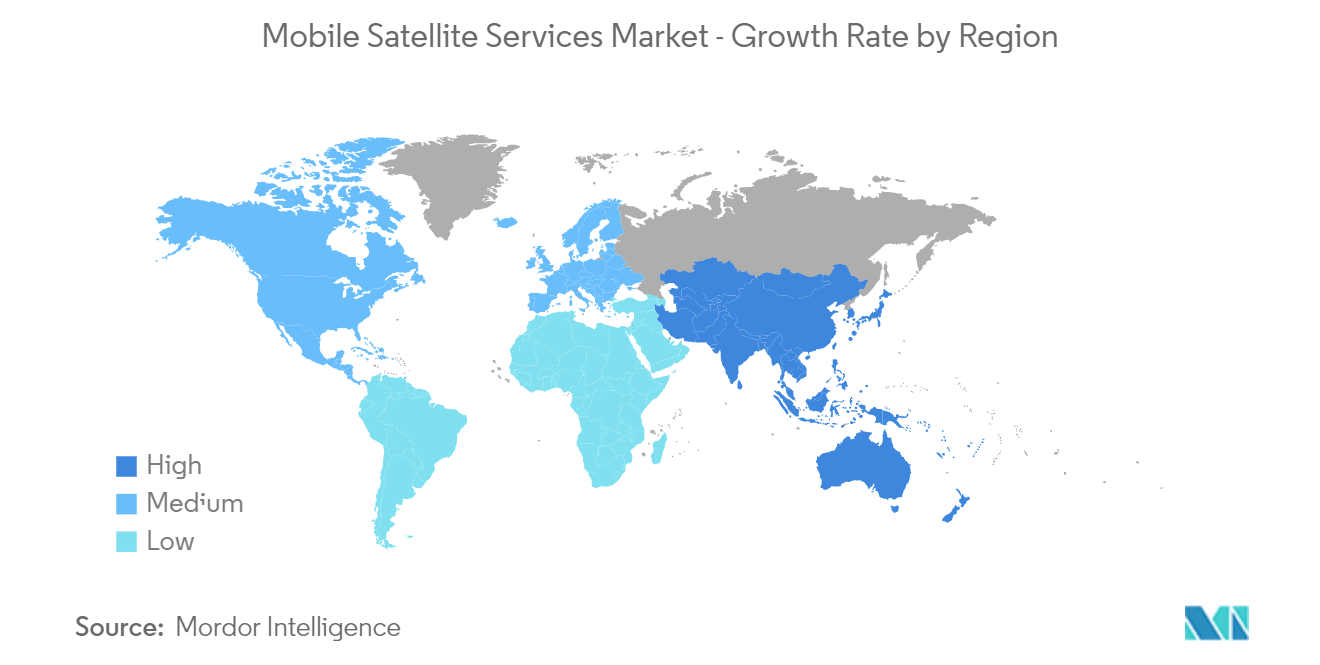Mobile Satellite Services (MSS) Market Analysis
The Mobile Satellite Services Market size is estimated at USD 5.29 billion in 2025, and is expected to reach USD 7.46 billion by 2030, at a CAGR of 7.11% during the forecast period (2025-2030).
The usage of satellite communication services for IoT, as well as in the disaster management areas in developed regions, is expected to boost the market studied over the forecast period.
- Mobile satellite services can find space for a wide range of applications, including telecommunication, weather prediction, navigation, military intelligence, and space exploration. Additionally, augmenting 5G mobile networks with next-generation satellite capabilities helps mobile satellite operators play a vital role in the emerging 5G ecosystem.
- Until recently, the MSS frequency bands were separate from the bands used for terrestrial cellular because the mobile user either needed a dual frequency band handset or two separate handsets. However, in the past decade, several system planners have proposed that segments of the MSS frequency bands be used for both terrestrial cellular and satellite communications so that the handsets might be simplified and the user's service is always through the same service provider.
- The terrestrial cellular network to support this mode of operation is called the ancillary terrestrial component (ATC). Although this will put additional burdens on the existing frequency allocations and require special precautions to protect GPS operations in adjacent bands, conditional approvals for the concept have already been obtained in the United States for the deployment of new integrated satellite and terrestrial networks using standard devices with form factors similar to current PCS/Cellular devices. There is a convergence between emerging wireless and mobile satellite services. Examples include the deployment of S-Band and L-Band integrated MSS networks in the United States by ICO Global Communications (DSDB recently acquired by Dish Network), TerreStar, and LightSquared.
- Interoperability is described as the ability of diverse information systems, devices, and applications to connect, in a synchronized manner, inter and intra-organizational boundaries to access, exchange, and cooperatively use the data amongst stakeholders. Data exchange architectures and standards allow relevant data to be shared effectively and securely within all applicable settings and with relevant stakeholders (including with the person whose information is being shared).
- Optimally, interoperability facilitates the connections and integrations across these communication systems to occur regardless of the data's origin or destination and ensures the data are usable and readily available to share without additional intervention by the end user. In the mobile satellite services market, the connection can happen between fixed satellite services to MSS or others as well. It requires the facilities to have interoperability; otherwise, the function may fail.
Mobile Satellite Services (MSS) Market Trends
Voice Service Segment is expected to register a Significant Growth
- Companies are offering portable and fixed phone services that provide essential voice calls and messaging for businesses operating in remote regions across the world. These voice services can be used on land, at sea, and in the air. They utilize advanced satellite communications networks, offering clear voice quality and minimal call dropout.
- For government agencies, voice mobile satellite services are an effective solution to manage coast guards and forest rangers, allowing them to help people on the borders and the islands. This is necessary during natural disasters.
- Apart from government agencies, businesses adopt voice satellite services to ensure continuous, uninterrupted communications for their crews in the fishery, mining, transport, construction, and tourism industries. Individual customers also benefit from voice satellite services, especially those who are always on the move or working in areas without cellular networks.
- Companies support polar adventurers by providing them with voice satellite services, which enable satellite connectivity for mobile devices that terrestrial networks cannot reach. For instance, Polar adventurer Antony Jinman used Iridium GO on his Antarctica trip.
- Companies are also adopting voice-based mobile satellite services to keep their employees connected with their families and close friends. For instance, INMARSAT offers one of the services called ChatCard, which helps to reduce feelings of isolation at sea by giving crewmembers the freedom to stay in touch with family and friends anywhere.
- For instance, American communications firm Viasat Inc. is headquartered in Carlsbad, California, and has other operations both domestically and abroad. Over 50% of Viasat's revenue in 2022 came from satellite services, with the balance coming from its product line. Viasat is a provider of secure networking solutions and high-speed satellite broadband services for the military and commercial markets. In the fiscal year 2022, the corporation made 2.8 billion dollars in revenue. Viasat's revenue steadily increased since 2019.
North America is expected to witness significant growth
- Among the lead innovators and pioneers in terms of adoption, North America is one of the largest markets for mobile satellite services. The growth in demand from end-user industries, such as government, maritime, and aviation, among others, is boosting the growth of the market in the region. Moreover, the region has advanced foothold technological infrastructure and improved network connectivity.
- The government agencies in the region have made significant efforts to introduce new satellite and navigation systems, which have further boosted the growth of the Satcom industry. For instance, in October 2022, in order to assist interested vendors in getting ready for potential solicitations in the fiscal year 2023, the U.S. Space Force released a list of future specifications for commercial satellite communications. The service mentioned that the 11 planned contracts for procurement are anticipated to last for the following 11 months. The estimated value of the five-year contract is between USD 620 million and USD 630 million.
- Another requirement listed is a recompete of a contract used to deliver Inmarsat's airborne broadband and Global Xpress services to the Department of Defense and other federal agencies. A potential five-year follow-on contract worth between USD 240 million and USD 250 million could be awarded in February 2023.
- Recently, SES GS announced that the U.S. General Services Administration's Future Satellite Communications Service Acquisition (FCSA) program had awarded SES Government Solutions the spot on the Complex Commercial Satellite Communications Solutions contract (CS3).
- This will likely allow the U.S. Government to take advantage of the most innovative offerings, including high throughput connectivity on a multi-orbit satellite fleet. Complex solutions will have any combination of fixed and mobile satellite services, service-enabling authorizations, components, and ancillary equipment, such as terminals, teleports, and peripherals.
Mobile Satellite Services (MSS) Industry Overview
The Mobile Satellite Services market is highly competitive and fragemented consists of several major players. In terms of market share, few of the major players currently dominate the market. These major players with a prominent share of the market are focusing on expanding their customer base across foreign countries. These companies are leveraging strategic collaborative initiatives to increase their market share and increase their profitability. The companies operating in the market are also acquiring start-ups working on Mobile Satellite Services technologies to strengthen their product capabilities.
- May 2023, it was reported that a new 8th generation of Inmarsat spacecraft will be developed by SWISSto12. The three I-8 satellites will provide further network resilience to ensure the continuation of Inmarsat's global L-band safety services for a long time.
- March 2023, Globalstar, Inc., announced that the Kingdom of Thailand's Office of The National Broadcasting and Telecommunications Commission (NBTC) has authorized the provision of Globalstar mobile satellite services throughout Thailand, including the authority to operate its new ground station at Thaicom's Teleport Center in Patumthani province north of Bangkok. Its new ground station at Thaicom's Teleport Center joins twenty-seven other stations in seventeen countries to provide the finest mobile satellite services, including critical Emergency SOS communications, to hundreds of millions of people globally.
- July 2022 - The Combat Capabilities Development Command of the U.S. Army awarded a contract to Kratos Defense & Security Solutions, Inc., a leading National Security Solutions provider, to showcase a virtualized SATCOM ground system. The solution, which is based on Kratos' OpenSpace Platform, will allow the government to deploy SATCOM networks in accordance with modernization objectives such as streamlining gateway and remote terminal capabilities supported by multiple vendors, lowering life-cycle costs, and assisting adaptive, dynamic space operations. The Network Command, Control, Communication, and Intelligence Cross-Functional Team (N-CFT), which was created by the Army's Future Command, provided funding for this award.
Mobile Satellite Services (MSS) Market Leaders
-
Globalstar Inc.
-
Ericsson Inc.
-
Inmarsat PLC
-
EchoStar Mobile Limited
-
Iridium Communications Inc.
- *Disclaimer: Major Players sorted in no particular order
Mobile Satellite Services (MSS) Market News
- March 2024 - Thuraya Telecommunications Company, the mobile satellite services subsidiary of Al Yah Satellite Communications Company PJSC, a leading satellite solutions provider in the UAE, has teamed up with Niflink. This collaboration aims to deliver tailored telemedicine and eLearning solutions through Thuraya's network, leveraging Niflink's cutting-edge video compression technology.
- February 2024 - GSOA and GSMA are dedicated to enhancing global communication capabilities through innovation, standardization, and value creation for their members and the wider telecommunications sector. Through a collaboration, the two associations are pooling their expertise and resources to push the boundaries of technology and capitalize on the synergies between mobile and satellite technologies.
Mobile Satellite Services (MSS) Industry Segmentation
Mobile satellite services (MSS) are the telecom services provided to mobile users with the help of satellite technology to establish communication between portable terminals or mobile devices. The availability of mobile communication beyond the terrestrial-based wireless system is a salient feature of MSS. The cost of mobile devices and the poor connection between mobile devices are key drawbacks of these services. MSS is used for emergencies such as distress, natural disasters, war zones, and breakdown of emergency communication.
The Mobile satellite services market is segmented by service (voice, data), end-user industry (maritime, enterprise, aviation, and government), and geography (North America, Europe, Asia-Pacific, Latin America, Middle East & Africa). The market sizes and forecasts are provided in terms of value in USD for all the above segments.
| By Service | Voice |
| Data | |
| By Geography*** | North America |
| Europe | |
| Asia | |
| Latin America | |
| Middle East and Africa | |
| By End-User Industry | Maritime |
| Enterprise | |
| Aviation | |
| Government |
Mobile Satellite Services (MSS) Market Research FAQs
How big is the Mobile Satellite Services Market?
The Mobile Satellite Services Market size is expected to reach USD 5.29 billion in 2025 and grow at a CAGR of 7.11% to reach USD 7.46 billion by 2030.
What is the current Mobile Satellite Services Market size?
In 2025, the Mobile Satellite Services Market size is expected to reach USD 5.29 billion.
Who are the key players in Mobile Satellite Services Market?
Globalstar Inc., Ericsson Inc., Inmarsat PLC, EchoStar Mobile Limited and Iridium Communications Inc. are the major companies operating in the Mobile Satellite Services Market.
Which is the fastest growing region in Mobile Satellite Services Market?
Asia Pacific is estimated to grow at the highest CAGR over the forecast period (2025-2030).
Which region has the biggest share in Mobile Satellite Services Market?
In 2025, the North America accounts for the largest market share in Mobile Satellite Services Market.
What years does this Mobile Satellite Services Market cover, and what was the market size in 2024?
In 2024, the Mobile Satellite Services Market size was estimated at USD 4.91 billion. The report covers the Mobile Satellite Services Market historical market size for years: 2019, 2020, 2021, 2022, 2023 and 2024. The report also forecasts the Mobile Satellite Services Market size for years: 2025, 2026, 2027, 2028, 2029 and 2030.
Our Best Selling Reports
Mobile Satellite Services Industry Report
Statistics for the 2025 Mobile Satellite Services market share, size and revenue growth rate, created by Mordor Intelligence™ Industry Reports. Mobile Satellite Services analysis includes a market forecast outlook for 2025 to 2030 and historical overview. Get a sample of this industry analysis as a free report PDF download.

-Market---key-players.webp)



-Market-Conc.webp)

